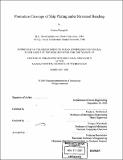Premature cleavage of ship plating under reversed bending
Author(s)
Muragishi, Osamu, 1961-
DownloadFull printable version (12.80Mb)
Other Contributors
Massachusetts Institute of Technology. Department of Ocean Engineering.
Advisor
Frank A. McClintock.
Terms of use
Metadata
Show full item recordAbstract
The objective of the thesis is to develop and apply testing methodology for fracture initiation of actual components of a ship's hull and to provide engineering design data to be used by the industry in predicting the effects of extreme loads such as accidents at sea or earthquakes. Since cleavage is more dangerous than ductile fracture, attention was focused on conditions controlling cleavage fracture. A careful inspection of damaged components of ships and structures damaged in the 1995 Kobe earthquake showed that fracture often initiates in the zones of large bending strains. It was found from the literature that tensile strains resulting from bending alone are not sufficient to cause fracture. A certain amount of reversed strain is needed. Also, temperature is an important parameter of the process. A comprehensive experimental program was undertaken to study the effects of pre-strain, reversed strain, and temperature. A total of 39 bending specimens cut from actual ship plating were tested and on that basis a 3-D failure surface was constructed for the AH36 steel, suitable for practical applications. The failure surface was formed in terms of compressive pre-strain, temperature, and reverse tensile strain. As-rolled plates pre-strained by -0.43 at room temperature with a Charpy 20 J work transition of 6⁰ C, cleaved with very small reversed strain of 0.011 at low service temperatures of-40⁰ C. Machining the surface, as done with conventional test specimens, raised the reversed strain to cleavage to 0.33. (cont.) Thus, a serious risk is hidden in the use of machined specimens in bending. Effects of other parameters such as aging were also studied on separate types of specimens. In addition, several mechanisms that could be responsible for the initiation of cleavage were identified and discussed in some depth. Because of the complex interaction between these various mechanisms and effects, it is not possible to make fracture prediction based on first principles. This difficulty necessitates conducting experiments on full-scale test specimens on ship plating which was one of the main objectives of the present thesis. In practical terms, the thesis gives a relatively simple method to chose a steel that could withstand anticipated accidental conditions.
Description
Thesis (Ph. D.)--Massachusetts Institute of Technology, Dept. of Ocean Engineering, February 2001. Includes bibliographical references (p. 71-75).
Date issued
2001Department
Massachusetts Institute of Technology. Department of Ocean EngineeringPublisher
Massachusetts Institute of Technology
Keywords
Ocean Engineering.